A shooting, sorrow and challenges in Chicago’s South Shore neighborhood
By by Bryan Crawford -Contributing Writer- | Last updated: Jul 25, 2018 - 10:13:46 AMWhat's your opinion on this article?

Chicago police released body camera footage of Harith Augustus, killed by a rookie officer on the city’s South Side on July 14.
|
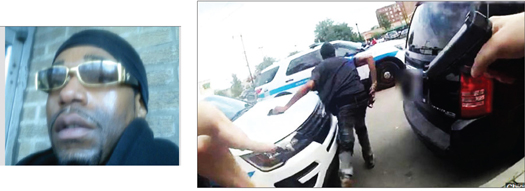
Harith “Snoop” Augustus | Many questioned why the video had no audio and asked if it had
been edited.
|
CHICAGO—It was a regular Saturday afternoon on 71st Street in the South Shore neighborhood before the shots rang out. Summertime along the strip where 37-year-old Harith “Snoop” Augustus, a barber at Sideline Studio, was shot and killed by a Chicago police officer, is usually busy and filled with people going in and out of the businesses in the area.
Perhaps this is one of the reasons protests mobilized so quickly after another Black man lost his life at the hands of the police. The clashes turned ugly as protestors threw objects at police, who swung batons and made arrests, shining a light on this predominantly Black community near Chicago’s coveted lakefront on the Southeast side of the city.
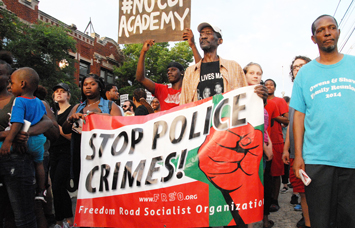
Protesters took to the streets in Chicago to express anger and outrage for another police shooting of a Black man in the city.
|
Within 24 hours of the shooting—an unprecedented amount of time for the city—the Chicago Police Department released body cam of Mr. Augustus’s encounter with several officers. In the end, a White female, rookie law enforcement officer fires fatal shots as the man spins and runs away as body cam video apparently shows a handgun and extra clip on his waistband underneath his shirt.
To many, however, what the police chief called “transparency” was an effort to calm unrest, and nothing more than a PR move to justify the officer’s actions—actions which essentially increased tension in a community that has been no stranger to often heavy handed and oftentimes, fatal policing.
“The relationship between the Chicago Police Department and the South Shore community is not a good one,” said William Calloway, a community activist and organizer who filed the original FOIA (Freedom of Information Act) request calling for the release of the Laquan McDonald police shooting video, and who spearheaded the police protest in the aftermath of the Augustus shooting. “This is the fourth or fifth fatal, officer-involved shooting in the past couple of years. We had Alfontish Cockerham in 2015. He was shot on 71st and Merrill, two blocks away from where Snoop was shot. Then you had Paul O’Neil in 2016. The police killed him in South Shore not far from 73rd and Merrill. Those were the most known incidents, but there have been others.”
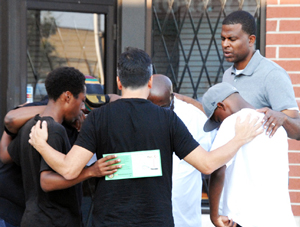
Demonstrators support and console one another.
|
Mr. Calloway stated that of Chicago’s 22 police districts, the 3rd District in South Shore leads in registered complaints by citizens against officers with respect to false arrests, illegal search and seizures, as well as excessive force.
“The relationship between the community and the police was already fractured before this shooting even happened,” Mr. Calloway added.
Police officials say the shooting victim had a firearm’s card allowing for weapons ownership but not a concealed carry permit.
A community breach and lack of trust
In the Black community, barbers and the barber shop can be just as esteemed as a pastor and a church. Barber shops are places of refuge. Barbers often serve as therapists, counselors and even big brothers, encouraging young people to take the right path and old heads dispensing wisdom. Since the police shooting involved someone tied to a fixture in Black life and culture maybe it was more unsettling.
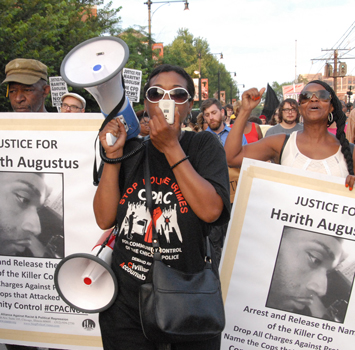
Residents of the South Shore area of the city where the shooting happened are fed up with violence.
|
“I never saw that coming, but it was a special day because he cut two people’s heads that meant something to me,” Mr. Hill explained to The Final Call. “One was a two-year-old who got his first haircut by Snoop. A member of Father Pfleger’s came in here and told me that he was the one who told that little boy’s father to bring him in here to get his haircut and Snoop was the one who did it and he walked out with a great cut. Then he cut a barber who just started here a couple of weeks ago, and he was the last person to get his hair cut by Snoop.”
Mr. Hill also expressed his frustration, sadness and anger over the loss to Chicago’s barber community.
“Yes, Snoop had a gun, but he was just trying to make it home safe in a rough community. Unfortunately, he didn’t make it home safe, and it wasn’t another Black man who killed him, it was the police,” Mr. Hill lamented. “They killed a barber. Do you know what a barber does for the community? Do you know what a barber means to the community? Snoop never talked much, but he didn’t have to because of what he did for people with how he made them feel after they got out of that chair and walked out of that door. In the culture of barbering in all communities, not just South Shore, our lives has been disturbed.”
What lies ahead?
Community members and activists are calling on Mayor Rahm Emanuel and the Chicago Police Department to release more than edited, silent bodycam video that shows Harith Augustus likely carrying a gun in his waistband. Is there audio to correspond with the video released to the public, which would help shed more light on what transpired leading up to the moment the officer fired her service weapon? What about body camera video from the other police officers, why hasn’t it been released?
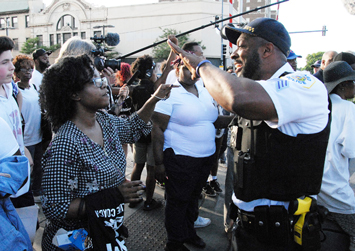
Protests have been ongoing in South Shore. Photos: Haroon Rajaee
|
Sydney Roberts, chief administrator of the Civilian Office of Police Accountability (COPA), during a recent Chicago Police Board meeting, acknowledged the call for more audio and video evidence, but said releasing information at this time could hamper and compromise the ongoing investigation.
Pamela Hunt, a South Shore resident present at the meeting, admonished police superintendent Eddie Johnson over the bodycam video, saying, “You released that tape because you wanted to show him with a gun. And you feel that’s a justified shooting. Officers don’t behave that way on the North Side. They’re creating situations to use deadly force. And it has to stop.”
South Shore is predominantly Black and the North Side is predominantly White in still highly racially segregated Chicago housing patterns.
Adonius Johnson is owner of Sideline Studio barbershop and author of the book, “I Am My Life Coach.” He feels one of the biggest issues contributing to tension between police and the Black community, not just in South Shore, is the largely hands off, impersonal, and disrespectful way officers patrol Black areas.
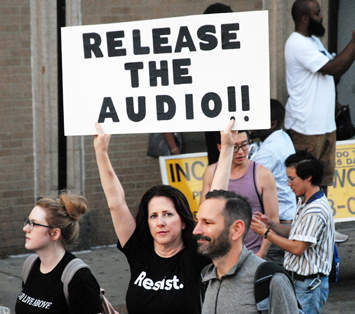
There have been repeated demands that audio from the police footage be released.
|
The average household size was about five people and median South Shore rent was $747 a month in 2016 versus average city rent of $916 a month. Average household income in South Shore was $41,284, but median income was $28,858 a year, according to www.point2homes.com.
On the up side, South Shore has great transportation options, including a commuter train that goes downtown and can connect with Indiana and Wisconsin. Speedy bus service and a direct drive via Lake Shore Drive also goes directly into downtown, while a major toll road expedites travel to Indiana and Michigan.
Many residents can walk to nearby Lake Michigan, enjoy a public golf course, parks, the beach and grassy picnic areas of the South Shore Cultural Center. Soon the Obama presidential center will rise just north of the neighborhood.
The historic Jackson Park Highlands section of South Shore offers multi-million dollar homes and baby mansions home to the likes of civil rights leader Jesse Jackson, other movers and shakers, successful professionals, executives and even University of Chicago employees. The Nation of Islam’s headquarters Mosque Maryam is located in South Shore and there is a relatively new international high school on Jeffrey Boulevard, a major street.
Some strongly believe neighborhood problems are tied to gentrification as longtime institutions like the Black United Fund, ABJ Community Services, the South Shore Chamber of Commerce, South Shore Works, the Southeast Side Block Club Alliance and Nation of Islam try to promote progress. South Shore has a farmers market, jazz performances, a profitable Starbuck’s franchise once owned by entrepreneur and basketball great Magic Johnson, Chef Sarah’s and other Black restaurants, several banks, an arts center and is a walk, bike, bus ride or short drive away from the South Side YMCA.
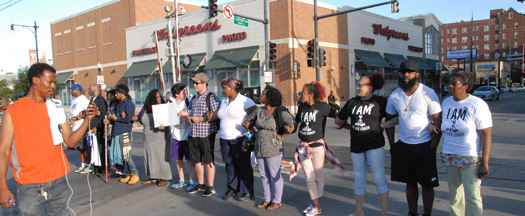
Men and women link arms near the railroad tracks on 71st and Jeffrey Blvd., near the area police shot and killed Harith "Snoop" Augustus.
|
The area near where the shooting took place, around 71st St. and Jeffrey Blvd., is problematic: Illegal activity and loitering can frustrate business owners and sporadic conflicts among young men, who could be better described as belonging to small cliques than the highly organized gangs back in the day, are not unusual.
Those factors can bring more police focus, but not enough police respect and outreach, said some residents.
“When the fire department wants to ask people for money, they’ll at least get out there with their boots and engage with the community. But police officers in the Black community just ride around in their cars, and there’s no relationship there,” Mr. Johnson told The Final Call. “The police are the ones who are supposed to help organize the block parties, the back-to-school giveaways, or the free water drives. Instead, they do things that gets the city sued for money it doesn’t have. They could use the money they have to give to a parent or whoever for the death of their child, and put it back in the community. This city has paid out millions in wrongful death money because of the police, and hasn’t given $10,000 to the community in free hot dogs or bottled water.”
Protests have slowed but peace doesn’t reign. Community leaders condemned the July 19 arrest and beating of activist Jedidiah Brown, who was leading a walking protest from corner to corner at 71st St. and Jeffrey Blvd. The action ended up with him being beaten, handcuffed, arrested and with an arm in a cast.
Val Free, of the Planning Commission, sees ugly police-community relations and doesn’t see hope for change unless there are more Black officers and a new District commander. “The police department does not respect our community and that’s a problem,” she said.
She can’t prove it, but like others, Ms. Free believes activist Brown was targeted by police. “He didn’t break a law and now he has a broken arm and God knows what else,” she said.
How does a walking protest result in a community leader having a broken arm? “Good question. That’s a question for the police department,” said Ms. Free. “I can’t even answer a question like that; it makes no sense of to me.”
“It’s sad that the police can try to, have the ability to, to lighten the hand or make the hand heavy, if we will,” commented Nkrumah English of the Black United Fund of Illinois. “ ‘Well we’ll lighten it because we know our officers were bogus in their approach and handling of Brother Augustus. So we’ll let them do this march now and we’ll be light-handed on this. Ok. We’re tired and here is a regular face that we see that’s always been an activist and so-called antagonist. We going to do something about him.’
“I think the Jedidiah Brown thing was a bit of the past and bit of ‘and now we’re going to let them see how we act. So when they come out here again, they’ll know we might be bustin’ heads,’ ” he said. “And I think that’s the culture of the police all the way from the Hill St. Blues days. … They still have that mentality and we have to adjust their mentality and we adjust their mentality through unification.”
(This is the first of a series of articles on Chicago’s South Shore neighborhood. Final Call staff contributed to this report.)
INSIDE STORIES AND REVIEWS
-
-
About Harriett ... and the Negro Hollywood Road Show
By Rabiah Muhammad, Guest Columnist » Full Story -
Skepticism greets Jay-Z, NFL talk of inspiring change
By Bryan 18X Crawford and Richard B. Muhammad The Final Call Newspaper @TheFinalCall » Full Story -
The painful problem of Black girls and suicide
By Charlene Muhammad -National Correspondent- » Full Story -
Exploitation of Innocence - Report: Perceptions, policies hurting Black girls
By Charlene Muhammad -National Correspondent- » Full Story -
Big Ballin: Big ideas fuel a father’s Big Baller Brand and brash business sense
By Bryan Crawford -Contributing Writer- » Full Story






 Click Here Stay Connected!
Click Here Stay Connected!








